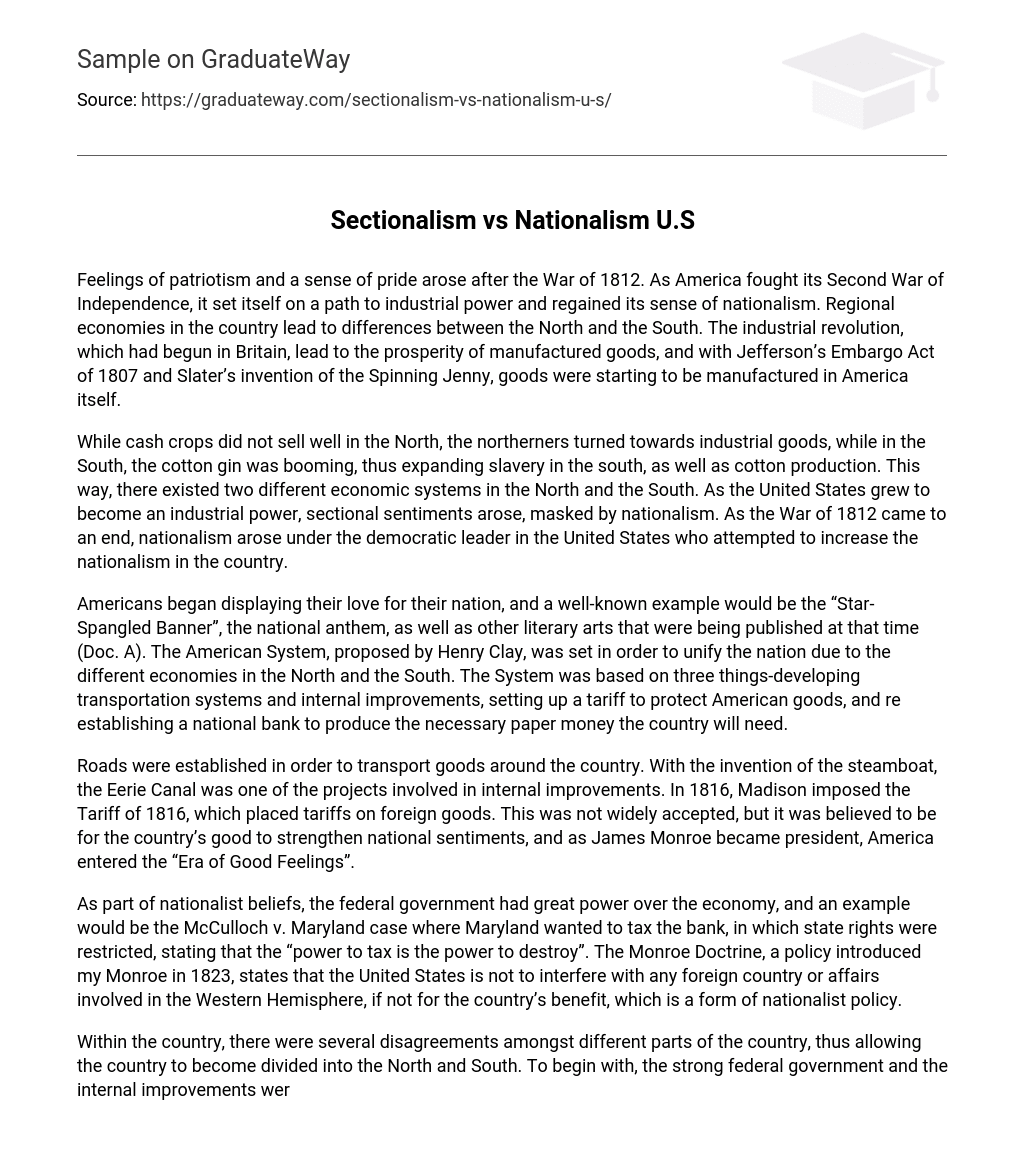Feelings of patriotism and a sense of pride arose after the War of 1812. As America fought its Second War of Independence, it set itself on a path to industrial power and regained its sense of nationalism. Regional economies in the country lead to differences between the North and the South. The industrial revolution, which had begun in Britain, lead to the prosperity of manufactured goods, and with Jefferson’s Embargo Act of 1807 and Slater’s invention of the Spinning Jenny, goods were starting to be manufactured in America itself.
While cash crops did not sell well in the North, the northerners turned towards industrial goods, while in the South, the cotton gin was booming, thus expanding slavery in the south, as well as cotton production. This way, there existed two different economic systems in the North and the South. As the United States grew to become an industrial power, sectional sentiments arose, masked by nationalism. As the War of 1812 came to an end, nationalism arose under the democratic leader in the United States who attempted to increase the nationalism in the country.
Americans began displaying their love for their nation, and a well-known example would be the “Star-Spangled Banner”, the national anthem, as well as other literary arts that were being published at that time (Doc. A). The American System, proposed by Henry Clay, was set in order to unify the nation due to the different economies in the North and the South. The System was based on three things-developing transportation systems and internal improvements, setting up a tariff to protect American goods, and re establishing a national bank to produce the necessary paper money the country will need.
Roads were established in order to transport goods around the country. With the invention of the steamboat, the Eerie Canal was one of the projects involved in internal improvements. In 1816, Madison imposed the Tariff of 1816, which placed tariffs on foreign goods. This was not widely accepted, but it was believed to be for the country’s good to strengthen national sentiments, and as James Monroe became president, America entered the “Era of Good Feelings”.
As part of nationalist beliefs, the federal government had great power over the economy, and an example would be the McCulloch v. Maryland case where Maryland wanted to tax the bank, in which state rights were restricted, stating that the “power to tax is the power to destroy”. The Monroe Doctrine, a policy introduced my Monroe in 1823, states that the United States is not to interfere with any foreign country or affairs involved in the Western Hemisphere, if not for the country’s benefit, which is a form of nationalist policy.
Within the country, there were several disagreements amongst different parts of the country, thus allowing the country to become divided into the North and South. To begin with, the strong federal government and the internal improvements were not favored by the South, which depended on mainly farming. Internal improvements benefited the North, which had larger number of establishments (Doc. E), in which it facilitated the means of transportation of goods, but the South saw no benefit in them, and therefore did not support it.
In the South, economy relied on plantation work, and therefore depended greatly on slave work. Hence, slavery very much expanded in the South, but not in the North. In 1818, the United States had a balanced number of states- 10 slave states and 10 free states, and then Alabama and Illinois were admitted as well, forming 11 slave states and 11 free states. When Missouri wanted to become an independent state, its numerous slave population would eventually make it a slave state.
In Document D, John Quincy Adams, a nationalist, discusses how he tolerated the Missouri Compromise, but thought it better if Missouri had never been admitted as a state in the very first place. At this point, sectionalism was at its highest point in America, but Henry Clay’s suggestion of making Maine a free state decreased the sectionalist sentiments that were beginning to rise in the country. The Election of 1828 marked a change in politics, in which Andrew Jackson won the presidency and began expanding democracy and bringing the country together.
Under his presidency, the “spoils-system” was introduced- in which officials were removed and replaced. Under Jackson’s presidency, there were the Whig and Democrat parties, in which he was a Democrat. While the Democrats were more farming-oriented, the Whigs were more of industrialists- this separation was an example of sectionalism within the government. But in attempt to unify the country, Jackson increased the tariff in 1828, in order to protect American goods.
The issue of states rights was constantly debated, and finally tested in 1832 when the Congress passed on a tariff (Doc. C) in South Carolina. The legislators opposed the tariff, threatening to withdraw from the American union, but Henry Clay, once again, came up with a solution to prevent the country from dividing itself. As a result, during this period of time, federal rights and state rights were under control. In conclusion, as the United States grew to become an industrial power, sectional sentiments arose, masked by nationalism.
Throughout the Era of Good Feelings and Jackson’s presidency, sectionalism was displayed on the issue of state and federal rights as well as that of slavery. Although at some points the country was divided- North and South, and Democrats and Whigs, the country was overall brought back together at a certain point. Despite the fact that several aspects would eventually lead to a civil war, during the Era of Good Feelings and Jackson’s presidency, the country was pretty much under control of the government.





